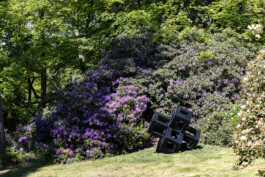
Giving art space in nature
The WAI sculpture park: A place of dialogue between art, nature and architecture
The WAI sculpture park is an exceptional example of the harmonious interplay of nature, art and architecture. Majestically situated on a plateau, the park extends over a vast, terraced area.
This impressive topography with a height difference of up to 48 meters ends on the picturesque banks of the Bille, where the river flows in a gentle bend into the mill pond. The artistic design, the variety of tree species and the carefully placed sculptures make the park a special place of silence and reflection, where people integrate into the natural landscape.
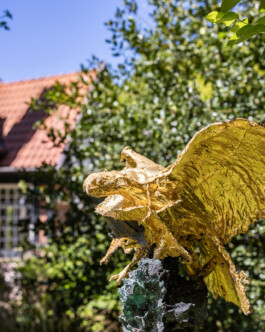
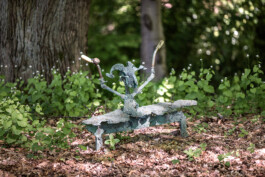
Erik Dietman, untitled (1988/89)
A triad of nature, art and architecture
The sculpture park symbolizes the constant dialogue between nature, art and architecture. Two architectural highlights embody this triad particularly impressively: the historic Tudor villa built in 1914/1921 and the contemporary exhibition house by Asmus Werner. The villa, with its striking bay windows, battlements and half-timbered elements, represents tradition and fits into the history of the park as an architectural jewel. In contrast to this is the simple exhibition house, which impresses with its clear lines and modern materials such as glass and steel. Together, these two buildings show how past and present come together harmoniously and thus contribute to the diversity of the park.
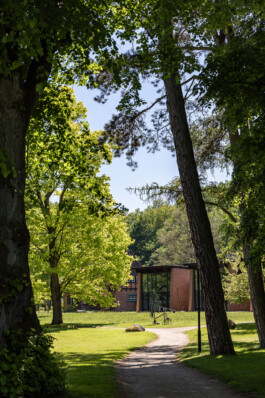
WAI Galleries
Designed nature and wild originality
The park is divided into different areas that demonstrate the balance between human design and untouched nature in a unique way.
The upper part of the park is dominated by nature organized by human hands. Groups of trees with golden elms, maples, oaks, silver lindens and weeping beeches are artfully arranged and testify to the vision of the landscape architect Rudolf Jürgens.
In contrast to this is the lower part of the park, which is known as the "wild jungle". Here, man has given nature free rein and the vegetation is allowed to grow unhindered. The change from ordered groups of trees to untamed nature conveys a unique tension that makes the park particularly attractive. The visitor experiences both man's control over nature and its untamed power and beauty - an experience that reminds us "that we like being in the great outdoors so much because it has no opinion of us," as Friedrich Wilhelm Nietzsche put it.
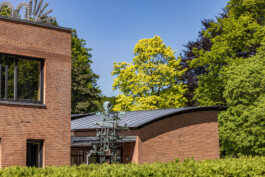
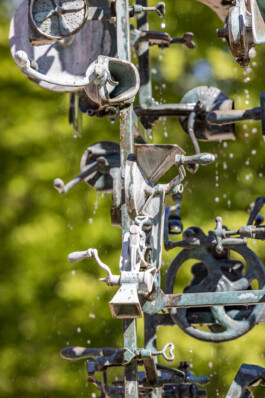
Daniel Spoerri, Il gocciolatoio - Der Tröpfler (1962/90)
Artistic interventions in harmony with nature
The sculpture park offers space for over 80 sculptures by international artists that blend into the landscape or deliberately contrast with it. This creates an exciting interplay between the works of art and the surrounding nature. Names such as Daniel Spoerri, Hellen Chadwick, Folkert de Jong and Karl Hartung are represented in the park.
An example of artistic integration into the landscape is the sculpture "Poseidon II" by Thomas Judisch, which directly refers to the Neptunian element in Rudolf Jürgens' park design.
Another artistic highlight is the installation "Dair" by Baldur Burwitz. This work, which is located in the dense forest of the "wild jungle", alludes to the symbolic meaning of trees in Celtic belief. The installation consists of up to 100 masks that are attached to the treetops and act like gates or portals that create a connection between the physical and an invisible, spiritual world. “Dair” is not only an artistic intervention, but a profound reflection on the connection between nature and human creation.
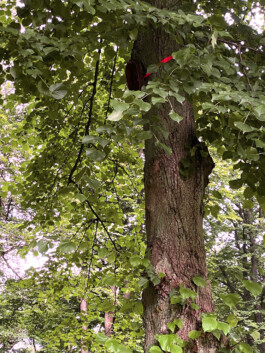
Baldur Burwitz, Dair (2021/24)
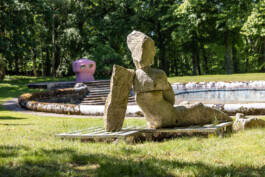
Atelier Van Lieshout, Workskull (Pink) (2005); Laura Eckert, Der Morgen (2017)
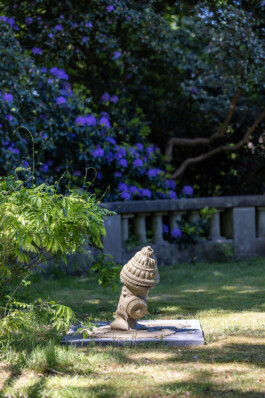
Mark Handforth, Weeping Hydrant (2005)
Sculpture parks in historical context
The WAI sculpture park follows in the tradition of large sculpture parks that became increasingly popular in the 20th century. Such parks are not only places where works of art are presented, but also offer new perspectives on the interaction between humans and nature. Unlike in museums or galleries, where works of art are shown in isolated rooms, sculptures in such facilities are deliberately embedded in the natural landscape. The viewer is invited to experience the works of art in the context of nature, which often leads to a more intense and direct aesthetic experience.
The sculpture park builds on this tradition and expands it through the unique combination of architecture, landscape design and art. In this park, nature itself becomes a kind of "stage" for art, while at the same time art intensifies the perception of nature. The park impressively shows how art and nature can not only coexist, but reinforce each other.
An experience for the senses and the soul
The WAI sculpture park is a place that appeals to the senses and touches the soul. Visitors are invited to wander through the various areas of the park, experience the harmony between the ordered nature and the wild originality and get involved in the artistic interventions. The balance between human control and the free flow of nature, between past and present and between architecture and art can be experienced here in an impressive way. The park is a space for reflection that invites visitors to experience nature in all its facets and to see art as an integral part of this experience.
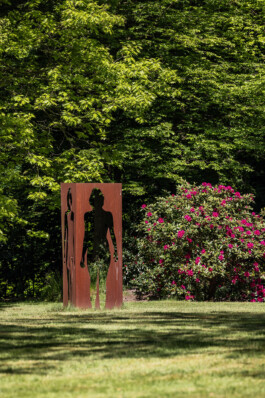
Werner Berges, Jede Menge Leute (2004)
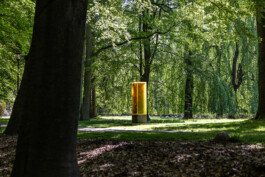
Folkert de Jong, Clairvoyant (2023)
EXHIBITED ARTISTS
Enrico Baj, Werner Berges, Bratta, Baldur Burwitz, Ambrogio Casatti, Helen Chadwick, Jake and Dinos Chapman, Will Coles, Das Bo, Folkert de Jong, Erik Dietman, Madeleine Dietz, Brad Downey, Felix Droese, Jimmie Durham, Laura Eckert, Henrik Eiben, Albert Feraud, Antony Gormley, Mark Handforth, Karl Hartung, Simon Hehemann, Allen Jones, Thomas Judisch, Wulf Kirschner, Terence Koh, Klaus Kumrow, Nate Lowman, Marder, Jonathan Monk, Wilhelm Mundt, Wolfgang Nestler, Darko Nikolic, Tim Noble, Joakim Ojanen, Wolfgang Petrick, Heinz Günter Prager, Marc Quinn, Arne Rautenberg, Ugo Rondinone, Ulrich Rückriem, Pierre Schumann, Daniel Spoerri, Stefan Strumbel, Paul Suter, Atelier Van Lieshout, Asim Waquif und Francisco Zuniga.
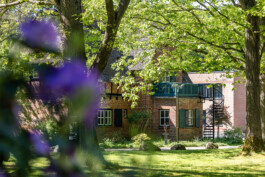

Giving art space in nature
The WAI sculpture park: A place of dialogue between art, nature and architecture
The WAI sculpture park is an exceptional example of the harmonious interplay of nature, art and architecture. Majestically situated on a plateau, the park extends over a vast, terraced area.
This impressive topography with a height difference of up to 48 meters ends on the picturesque banks of the Bille, where the river flows in a gentle bend into the mill pond. The artistic design, the variety of tree species and the carefully placed sculptures make the park a special place of silence and reflection, where people integrate into the natural landscape.

Folkert de Jong, Territory Revolt #2 (Buzzard) (2016)

Erik Dietman, untitled (1988/89)
A triad of nature, art and architecture
The sculpture park symbolizes the constant dialogue between nature, art and architecture. Two architectural highlights embody this triad particularly impressively: the historic Tudor villa built in 1914/1921 and the contemporary exhibition house by Asmus Werner. The villa, with its striking bay windows, battlements and half-timbered elements, represents tradition and fits into the history of the park as an architectural jewel. In contrast to this is the simple exhibition house, which impresses with its clear lines and modern materials such as glass and steel. Together, these two buildings show how past and present come together harmoniously and thus contribute to the diversity of the park.

WAI Galleries
Designed nature and wild originality
The park is divided into different areas that demonstrate the balance between human design and untouched nature in a unique way.
The upper part of the park is dominated by nature organized by human hands. Groups of trees with golden elms, maples, oaks, silver lindens and weeping beeches are artfully arranged and testify to the vision of the landscape architect Rudolph Jürgens.
In contrast to this is the lower part of the park, which is known as the "wild jungle". Here, man has given nature free rein and the vegetation is allowed to grow unhindered. The change from ordered groups of trees to untamed nature conveys a unique tension that makes the park particularly attractive. The visitor experiences both man's control over nature and its untamed power and beauty - an experience that reminds us "that we like being in the great outdoors so much because it has no opinion of us," as Friedrich Wilhelm Nietzsche put it.


Daniel Spoerri, Il gocciolatoio - Der Tröpfler (1962/90)
Artistic interventions in harmony with nature
The sculpture park offers space for over 80 sculptures by international artists that blend into the landscape or deliberately contrast with it. This creates an exciting interplay between the works of art and the surrounding nature. Names such as Daniel Spoerri, Hellen Chadwick, Folkert de Jong and Karl Hartung are represented in the park.
An example of artistic integration into the landscape is the sculpture "Poseidon II" by Thomas Judisch, which directly refers to the Neptunian element in Rudolph Jürgens' park design.

Baldur Burwitz, Dair (2021/24)
Another artistic highlight is the installation "Dair" by Baldur Burwitz. This work, which is located in the dense forest of the "wild jungle", alludes to the symbolic meaning of trees in Celtic belief. The installation consists of up to 100 masks that are attached to the treetops and act like gates or portals that create a connection between the physical and an invisible, spiritual world. “Dair” is not only an artistic intervention, but a profound reflection on the connection between nature and human creation.

Atelier Van Lieshout, Workskull (Pink) (2005); Laura Eckert, Der Morgen (2017)

Mark Handforth, Weeping Hydrant (2005)
Sculpture parks in historical context
The sculpture park follows in the tradition of large sculpture parks that became increasingly popular in the 20th century. Such parks are not only places where works of art are presented, but also offer new perspectives on the interaction between humans and nature. Unlike in museums or galleries, where works of art are shown in isolated rooms, sculptures in such facilities are deliberately embedded in the natural landscape. The viewer is invited to experience the works of art in the context of nature, which often leads to a more intense and direct aesthetic experience.
The WAI sculpture park builds on this tradition and expands it through the unique combination of architecture, landscape design and art. In this park, nature itself becomes a kind of "stage" for art, while at the same time art intensifies the perception of nature. The park impressively shows how art and nature can not only coexist, but reinforce each other.

Werner Berges, Jede Menge Leute (2004)
An experience for the senses and the soul
The WAI sculpture park is a place that appeals to the senses and touches the soul. Visitors are invited to wander through the various areas of the park, experience the harmony between the ordered nature and the wild originality and get involved in the artistic interventions. The balance between human control and the free flow of nature, between past and present and between architecture and art can be experienced here in an impressive way. The park is a space for reflection that invites visitors to experience nature in all its facets and to see art as an integral part of this experience.

Folkert de Jong, Clairvoyant (2023)
EXHIBITED ARTISTS
Enrico Baj, Werner Berges, Bratta, Baldur Burwitz, Ambrogio Casatti, Helen Chadwick, Jake and Dinos Chapman, Will Coles, Das Bo, Folkert de Jong, Erik Dietman, Madeleine Dietz, Brad Downey, Felix Droese, Jimmie Durham, Laura Eckert, Henrik Eiben, Albert Feraud, Antony Gormley, Mark Handforth, Karl Hartung, Simon Hehemann, Allen Jones, Thomas Judisch, Wulf Kirschner, Terence Koh, Klaus Kumrow, Nate Lowman, Marder, Jonathan Monk, Wilhelm Mundt, Wolfgang Nestler, Darko Nikolic, Tim Noble, Joakim Ojanen, Wolfgang Petrick, Heinz Günter Prager, Marc Quinn, Arne Rautenberg, Ugo Rondinone, Ulrich Rückriem, Pierre Schumann, Daniel Spoerri, Stefan Strumbel, Paul Suter, Atelier Van Lieshout, Asim Waquif und Francisco Zuniga.

FOLLOW US ON INSTAGRAM
WOODS ART INSTITUTE
GOLFSTRASSE 5, 21465 WENTORF NEAR HAMBURG
INFO@WOODSARTINSTITUTE.COM
@woodsartinstitute ON INSTAGRAM
WAI WOODS ART INSTITUTE
GOLFSTRASSE 5
21465 WENTORF NEAR HAMBURG